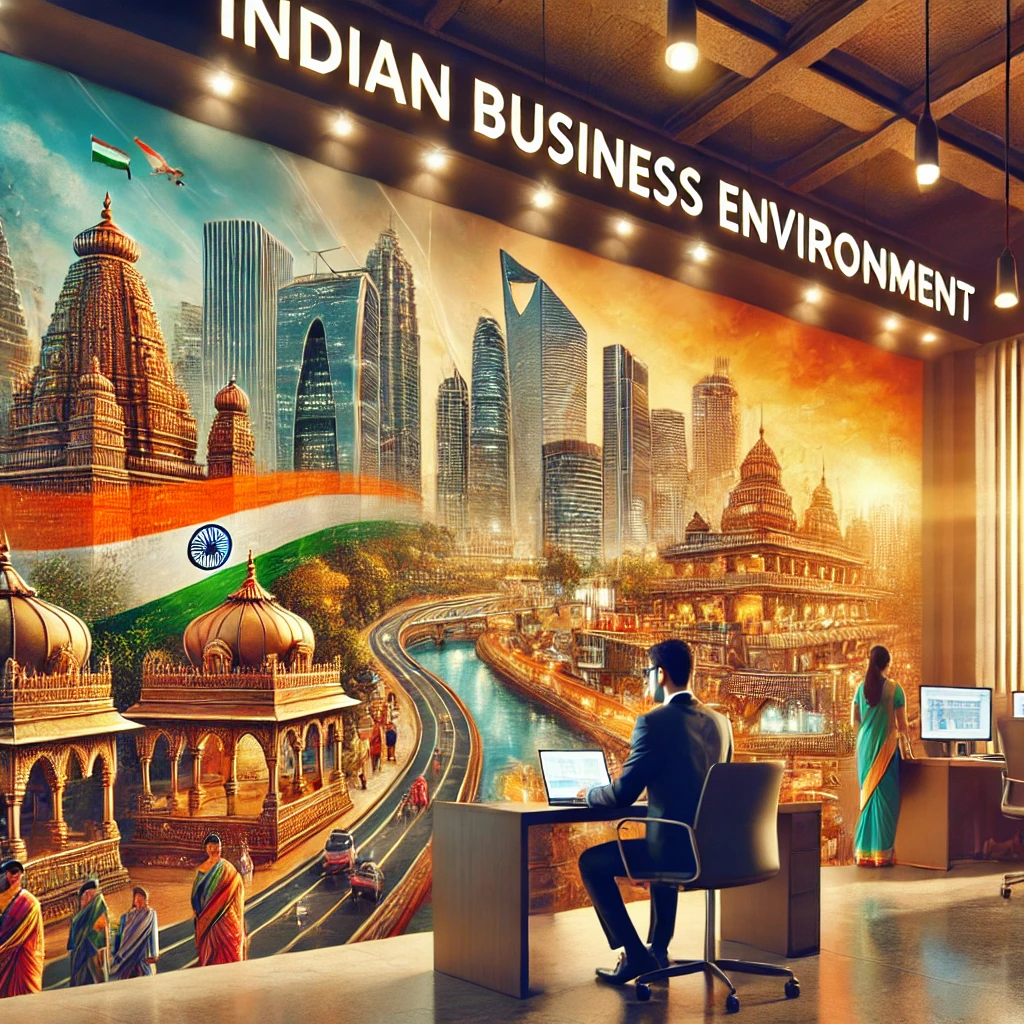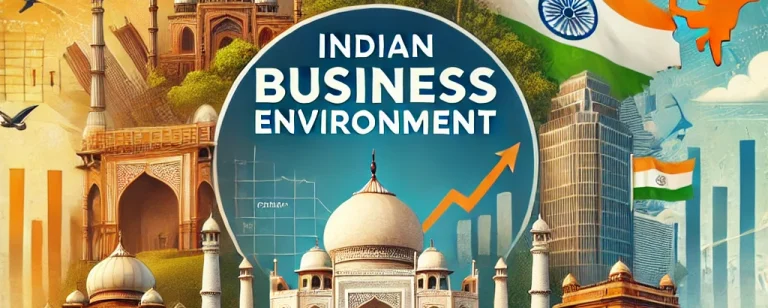Indian business environment refers to factors, forces, and conditions that shape business operations in India. The Indian business environment comprises all those economic, political, legal, technological, and social factors that form the business environment. Entrepreneurs, companies, and policymakers need to understand the Indian business environment to make proper decisions and survive in the competitive marketplace.
Features of Indian Business Environment
The Indian business environment is different because of a set of factors that influence the way business operations take place in India. These elements constitute the economy, society, culture, politics, and technology that affect business performance by providing scope and limitations to them. Let’s take a detailed look at all these aspects.
Economic Factors
India has a mixed economy. It comprises private as well as public sector business undertakings. The nature of economic structure has significantly influenced the business environment. India has a huge economy, ranking as the 5th largest in the world, and its rapid growth has led to increased consumer demand and business opportunities.
The Indian government has always brought forth pro-business reforms, particularly since the 1991 economic liberalization. Market-friendly policies by the government have opened the door to both domestic and international companies. The growing middle class of India also fuels demand for a wide range of goods and services.
Some of the key economic features of India’s business environment include:
- Large Market Size: With over 1.4 billion people, India has one of the largest consumer markets in the world. This attracts global businesses seeking expansion.
- Young Workforce: India’s youthful demographic provides businesses with a large, energetic labor force. The average age of the population is 29 years, which makes it attractive to industries such as tech, retail, and consumer goods.
- GDP Growth: India’s GDP growth rate remains consistently high, making it an attractive destination for investment.
- Global Trade: India is becoming a hub for international trade, benefiting from trade agreements and access to emerging markets.
Political Factors
India is a democratic republic, and the political environment is an important factor shaping the business climate. Laws and policies, from tariffs in trade to taxation policies, are enacted by the government, thus influencing the business environment.
- Government Stability: India has a stable political environment, with regular elections and a strong rule of law. The government actively encourages foreign investment by reducing barriers and creating favorable policies.
- Regulation and Laws: Indian businesses must navigate a complex regulatory framework. This includes labor laws, environmental regulations, and corporate governance standards that influence business operations.
- Political Parties: The dominance of certain political parties at the national and regional levels can influence business policies. For instance, the government’s approach to taxation and subsidies is a key factor affecting industries.
Political stability and pro-business policies foster a positive environment for business growth. However, regional differences and the complexity of India’s political structure can sometimes cause delays and inefficiencies.
Technological Factors
Technology has transformed the Indian business environment, with advancements in IT, digital payments, and e-commerce creating new opportunities for businesses. Technological advancements are continually evolving, which forces businesses to adapt and invest in new technologies to remain competitive.
- Technological Advancements: India has become a global leader in information technology services. This technological prowess drives innovation across various sectors, including healthcare, finance, and education.
- Digital Transformation: The growth of internet access, smartphones, and digital platforms has opened up new avenues for businesses to connect with consumers.
- R&D Investments: The Indian government has incentivized research and development, promoting innovation and helping businesses stay competitive in the global market.
Social and Cultural Factors
The social and cultural environment in India is one that determines how businesses function and thrive. The diverse cultures, religions, and traditions in India have an impact on consumer behavior, marketing strategies, and corporate governance.
- Consumer Preferences: India is a country with a rich cultural diversity. The tastes and preferences of consumers vary across different regions. Understanding these preferences helps businesses tailor their products and services to specific demographics.
- Social Movements: India has witnessed several social movements in recent years, which have had a profound impact on businesses. Movements for gender equality, environmental sustainability, and social justice have forced companies to reassess their business practices.

Constraints of Indian Business Environment
While the Indian business environment offers tremendous opportunities, it also presents several challenges that businesses must overcome to succeed. These constraints can affect business growth and the ease of doing business.
Bureaucracy and Red Tape
Despite the continuous reforms and liberalization, India faces an excessive bureaucracy. Business is increasingly plagued by delays due to lengthy procedures in opening new businesses, acquiring permits, and compliance with regulatory requirements. Thus making the approval a lengthy and costly process of approval, especially for companies coming from abroad.
- Long Approval Times: Securing licenses and permits can take months or even years, which creates hurdles for businesses.
- Multiple Layers of Government: India’s federal structure means that businesses must deal with multiple levels of government—local, state, and national.
Infrastructural Challenges
While India has made significant progress in improving infrastructure, the country still faces challenges in areas like transport, logistics, and energy supply.
- Transport and Logistics: Traffic congestion, poor road conditions, and inadequate public transport networks make logistics expensive and time-consuming.
- Energy Issues: Power shortages are a common issue in many regions, making it difficult for businesses to operate smoothly.
Despite improvements, infrastructural challenges still exist and affect businesses in India, especially in rural areas.
Corruption
Corruption is the biggest issue in India concerning government dealings. It often leads to businesses paying their way for permits, licenses, and contracts. This corruption can increase operational risks and hinder growth, especially when businesses lack local connections.
- Impact on Business Costs: Companies may incur additional costs due to corruption, which reduces profitability.
- Regulatory Hurdles: Corruption often leads to delays and inefficiencies in regulatory processes, making it harder to navigate the business environment.
Labor Laws and Unionization
India’s labor laws are very complex and quite rigid. Businesses looking to lay off employees or restructure their operations can be bogged down with legal problems. Worker unions are powerful in some sectors and can result in strikes or other labor disruptions.
- Rigid Labor Laws: Strict laws regarding layoffs, worker rights, and wages can make it difficult for businesses to make quick adjustments.
- Labor Unrest: In some industries, unions have considerable influence, and labor disputes can lead to strikes that disrupt business operations.
Impact of GST on Indian Business Environment
One of the very significant tax reforms in India has been the Goods and Services Tax, which the government implemented in 2017. This aimed at simple structuring, creating unified taxation, and reducing multi-tax cascading effects on the Indian business environment, which have had both a positive and negative impact on the business environment.
Simplification of Taxation
India’s tax system was complex under the previous regime, and there were several state and central taxes, such as VAT, service tax, and excise duties. GST has integrated that complex multi-layered structure under a singular tax system. It has helped the business community comply with these tax regulations straightforwardly.
- One Tax Structure: The implementation of a single tax system reduced the compliance burden on businesses, which previously had to navigate several state and central taxes.
- Transparency: The introduction of GST made the tax system more transparent, as businesses are now required to maintain accurate records and file returns online.
Streamlined Supply Chain and Logistics
GST has made the supply chain and logistics sector more streamlined by eliminating multiple state-level taxes and inspections. The interstate tax barriers have been reduced, thereby helping improve the flow of goods and services.
- Faster Movement of Goods: With the elimination of state-level border checks, goods can now be transported more easily across state borders, reducing transportation time.
- Cost Reduction: Businesses benefit from lower transportation costs due to fewer checkpoints and faster movement of goods.
GST has positively impacted businesses by enhancing operational efficiency in logistics.
Increased Compliance Costs
While GST has simplified the taxation process, it has also led to increased compliance costs for businesses. Companies need to invest in accounting systems and software to comply with GST filing requirements.
- Technology Investment: To comply with GST, businesses need to implement new technology and accounting systems, which can be costly.
- Training and Documentation: Businesses have to train staff and maintain proper documentation to meet GST requirements, further increasing costs.
Impact of Globalization on Indian Business Environment
Globalization has had a profound impact on the Indian business environment. The integration of India into the global economy has created new opportunities for growth while presenting several challenges for businesses.
Increased Foreign Investment
Globalization has opened the doors for foreign direct investment (FDI) in India. The Indian government has relaxed many regulations and policies, making it easier for international businesses to enter the market.
- FDI in Retail: Foreign companies can now invest in retail businesses, including e-commerce, making India an attractive market for global retailers.
- Technology Transfer: Globalization has also facilitated the transfer of technology to India, benefiting industries such as IT, automotive, and manufacturing.
Exposure to Global Competition
While globalization has made many new opportunities available for India, it has made it vulnerable to more competition than foreign companies. Many such firms have entered the Indian markets offering quality products at competitively low prices.
- Increased Competition: Local businesses now face competition from multinational companies with greater resources and expertise.
- Quality Standards: Globalization has raised the bar for quality standards, forcing Indian businesses to improve their products and services.
Indian businesses have had to adapt to these challenges by upgrading their technology, improving efficiency, and focusing on innovation.
Cultural Influence
Globalization has also led to the cultural exchange between India and other countries. Foreign brands and products have influenced the tastes and preferences of Indian consumers.
- Consumer Behavior: As consumers are exposed to international brands, their expectations have increased. This has led Indian businesses to innovate and enhance their offerings.
- Changing Lifestyles: Globalization has introduced new lifestyles and consumption patterns, which have created new market opportunities for businesses.
Indian companies must be proactive in understanding and meeting these evolving consumer demands.
Indian Business Environment FAQs
What are the main features of the Indian business environment?
The Indian business environment is characterized by a large market size, economic growth, political stability, and diverse consumer needs. Key factors such as a young workforce, technological advancements, and social diversity shape business operations in India.
How does GST impact businesses in India?
GST simplifies the taxation system by replacing multiple taxes with a single one, improving transparency, and streamlining supply chains. However, it has also led to increased compliance costs due to the need for new systems and documentation.
What are the main constraints in the Indian business environment?
The main constraints include bureaucratic delays, infrastructural challenges, corruption, and rigid labor laws. These factors make it difficult for businesses to operate efficiently.
How does globalization affect Indian businesses?
Globalization increases foreign investment and exposes businesses to global competition. It also influences consumer behavior and forces companies to improve their quality and efficiency to remain competitive.
What are the impacts of globalization on the Indian economy?
Globalization has opened doors for foreign direct investment, raised competition, and introduced new lifestyles and consumption patterns. It has also driven technological advancements and improved business practices in India.


